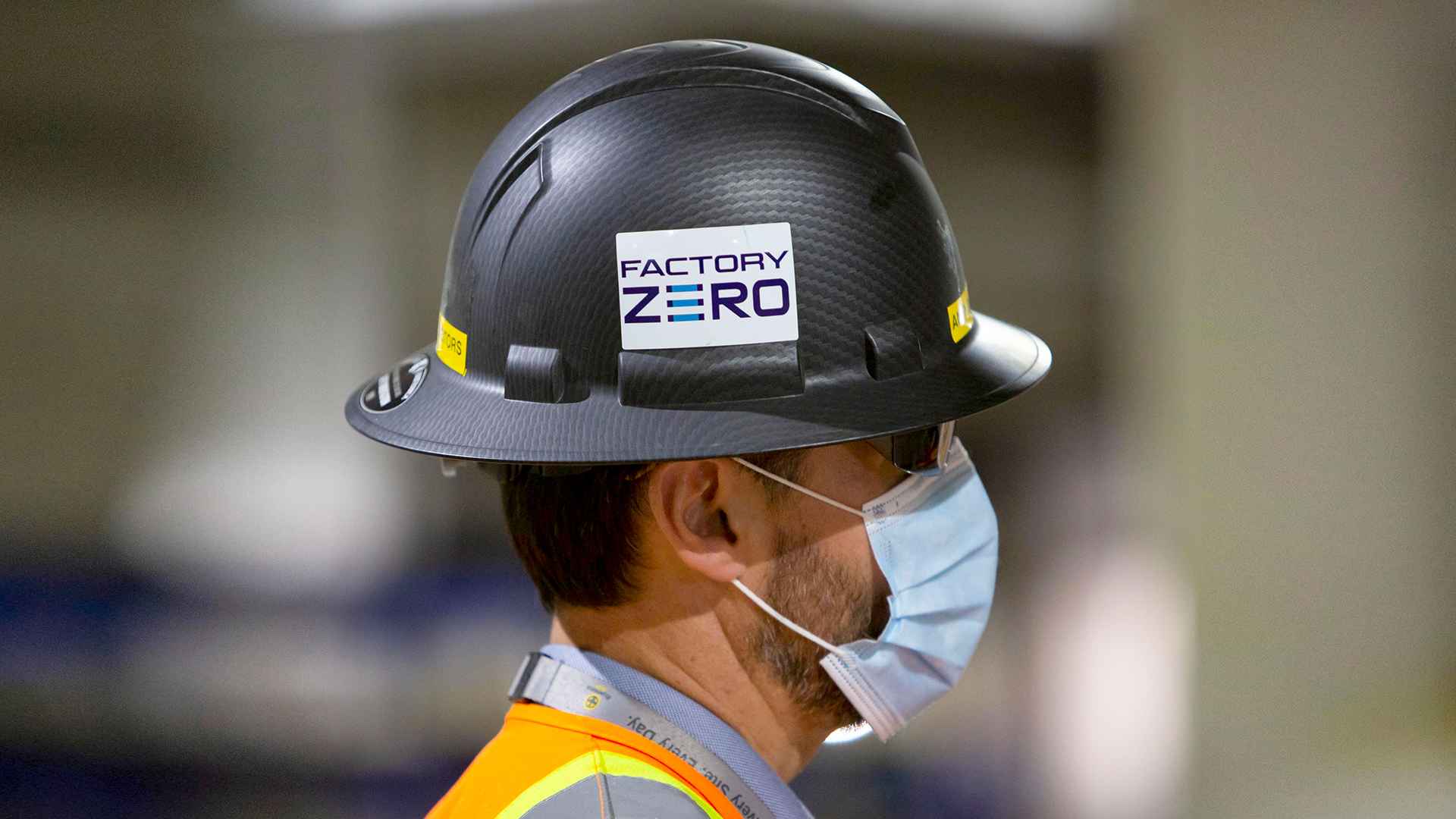| |
| |
| |
| Presented By General Motors |
| |
| Axios What's Next |
| By Jennifer A. Kingson, Joann Muller and Erica Pandey ·Nov 15, 2021 |
| America is bleeding teachers, and the reasons aren't hard to fathom. A not-so-fun fact from today's newsletter: It pays more to work at McDonald's than be a substitute teacher. - Today's photo was taken by our own Jennifer A. Kingson while attending a glam event at Hudson Yards in Manhattan. (Was that a brag?)
- Do you see a shiny new object that you want to showcase in the daily photo spot? Email: whatsnext@axios.com.
Today's Smart Brevity count: 1,047 words ... 4 minutes. |
| |
| |
| 1 big thing: America's teacher shortage will outlast the pandemic |
 |
|
| Illustration: Rae Cook/Axios |
| |
| The pandemic triggered a teacher exodus, and the shortage of instructors is still squeezing America's schools, Erica Pandey writes. The big picture: Demand for teachers is drastically outpacing supply. Many teachers are retiring or quitting the profession due to pandemic-era stress, and universities aren't minting new ones fast enough. Why it matters: Schools are hurriedly navigating the shortage, switching to virtual learning or closing down on certain days entirely. And the quality of students' education is at stake, as Axios' Erin Doherty reports. - "It's a problem that existed pre-pandemic, it has been exacerbated by the pandemic, and the teacher shortage will not disappear with the pandemic," says Michael Rice, Michigan's state superintendent of public instruction.
By the numbers: Nationally, there were 575,000 fewer local and state education employees in October 2021 than in February 2020, according to the latest jobs report. - And while health concerns and the stress of flitting between virtual and in-person education drove teachers, school support staff and administrators out in 2020, they're not coming back to school even as the pandemic subsides.
- A net 65,000 public education employees left the industry between September and October alone, per the Bureau of Labor Statistics.
What's happening: Teacher pay increases have long lagged the rest of the comparably educated workforce, with a gap of about 21% in 2018. That disparity was 6% in 1996, according to an analysis from the Economic Policy Institute. - And while teachers' pay has gone up alongside that of other workers, teacher wage gains in the last quarter were 0.7%, compared with the 1.5% average for all civilian workers.
- That's pushing existing instructors to pivot to new careers and discouraging new college graduates from becoming teachers.
- "Our state universities aren't producing enough teachers for the state," Justin Fryer, superintendent of Lisbon Public Schools in North Dakota, tells Axios.
The effect: When teachers take days off or have to enter quarantine due to COVID-19, districts can't backfill them. "Finding substitutes has been a tremendous problem," Fryer says. - It pays more to work at McDonald's than be a substitute teacher in the U.S., Bloomberg reports.
Read the full story. |
    |
| |
| |
| 2. The end of after-hours work texts in Portugal |
 |
|
| A view of Lisbon, Portugal. Photo: Jose Sarmento Matos/Bloomberg via Getty Images |
| |
| Portugal has a new set of laws for teleworkers. Among other things, it's now illegal for bosses to text or email employees after work except in exceptional circumstances, AP reports. Why it matters: Countries are drumming up specific legislation for teleworkers as they become a more permanent fixture of the working world. - Another new law is that companies are responsible for covering work-from-home costs like higher electricity bills.
- But not all the proposed laws were approved by the Portuguese parliament. One that wasn't adopted was the "right to disconnect," which would have allowed employees to turn off work devices and messaging apps after hours, Insider reports.
What to watch: Portugal's beefed-up labor laws for remote workers could attract more digital nomads from other countries. |
    |
| |
| |
| 3. U.S. unveils road map for net-zero aviation emissions by 2050 |
 |
|
| Photo: Massimo Insabato/Archivio Massimo Insabato/Mondadori Portfolio via Getty Images |
| |
| The Transportation Department unveiled a road map to slash greenhouse gas emissions from the U.S. aviation sector with a target of reaching net-zero by 2050, Ben Geman writes in Axios Generate. Why it matters: Aviation accounts for about 3% of global carbon emissions, but has other warming impacts too. It accounts for 11% of U.S. transportation-related emissions, according to the White House. - Those emissions are projected to rise a lot in coming decades alongside the growth of air travel, absent aggressive adoption of climate-friendly tech.
- In a hypothetical case of technology frozen in place, the strategy estimates that U.S. aviation emissions in 2050 would be around twice their 2019 levels.
Driving the news: The department just released its first "Aviation Climate Action Plan" that aims to further R&D and deployment of technologies that attack the problem in a suite of ways. - The plan seeks to spur development and uptake of sustainable aviation fuels (SAFs) for long-haul flights, as well as battery and hydrogen propulsion on shorter routes. SAFs do the heaviest lifting in the department's pathway to net-zero by midcentury.
- Another goal is to help speed efficiency gains, with a target to "demonstrate a suite of aircraft technologies by 2030 to achieve a 30% improvement" relative to today's best tech.
- While burning jet fuel comprises the vast majority of the sector's emissions, airports generate CO2 through ground operations, which is also a focus of the plan.
The bottom line: More help from Congress is also likely needed to help put U.S. aviation on anything resembling the pathway envisioned in the report. Read the full story. |
    |
| |
| |
| A message from General Motors |
| Driving the future of America |
| |
 |
| |
| The all-electric future will be made by American labor.* From producing our revolutionary new Ultium Platform to the first electric vehicles it will power, we're investing billions not just in EVs and AVs, but in American manufacturing itself. Disclaimer: *Built from globally sourced parts. |
| |
| |
| 4. IoT projected to generate up to $12.6 trillion by 2030 |
 |
|
| Illustration: Shoshana Gordon/Axios |
| |
| From smart home devices to sensor-laden factories, the Internet of Things (IoT) is poised to generate trillions of dollars by the end of the decade, according to a new report from the McKinsey Global Institute (MGI), Bryan Walsh writes in Axios Future. The big picture: The IoT is where the digital and physical worlds converge. - But just how large the IoT eventually becomes will come down less to technological development than to ensuring connected devices can operate together and countering cybersecurity concerns.
By the numbers: MGI estimates by 2030 the IoT could enable between $5.5 trillion and $12.6 trillion in value globally. - About 65% of that value is projected to be created in business-to-business applications, like smart factories or offices, rather than consumer applications like internet-connected robot vacuums.
- The IoT economy is predicted to lean toward developing countries — which benefit from being able to build smart facilities from the ground up rather than retrofitting — and China in particular, which MGI expects will generate more than a quarter of all IoT value by 2030.
The catch: It's far from certain all of this economic value will be realized. Read the full story. |
    |
| |
| |
| 5. Photo of the day |
 |
|
| Sparkly trees in front of the laugh-out-loud expensive shopping mall at Hudson Yards in New York City. Photo: Jennifer A. Kingson/Axios Media |
| |
| What's Next: Have yourself a pretty little Christmas Jennifer A. Kingson writes: "Everything about the (relatively) new Hudson Yards development on the far west side of Manhattan says 'money' and 'opulence' — the luxury apartments, hotel and gym; the dazzling restaurants and the designer-studded indoor mall. "When I visited last week, this tableau captured the essence of the holiday season in Manhattan: Walking in the dark amidst beautifully lit trees, while retailers pull out the stops to draw you in. "Holiday 2021 has a different and less consumer-y feel. The supply chain madness that's making 'stuff' harder to buy is putting a premium on mood-lifting experiences and glimpses of sudden and unexpected joy." |
    |
| |
| |
| A message from General Motors |
| Driving the future of America |
| |
 |
| |
| The all-electric future will be made by American labor.* From producing our revolutionary new Ultium Platform to the first electric vehicles it will power, we're investing billions not just in EVs and AVs, but in American manufacturing itself. Disclaimer: *Built from globally sourced parts. |
| |
| Hard up for a holiday gift? Wrap up a free subscription to Axios What's Next by filling out a simple form here. |
 | | It'll help you deliver employee communications more effectively. | | |









No comments:
Post a Comment